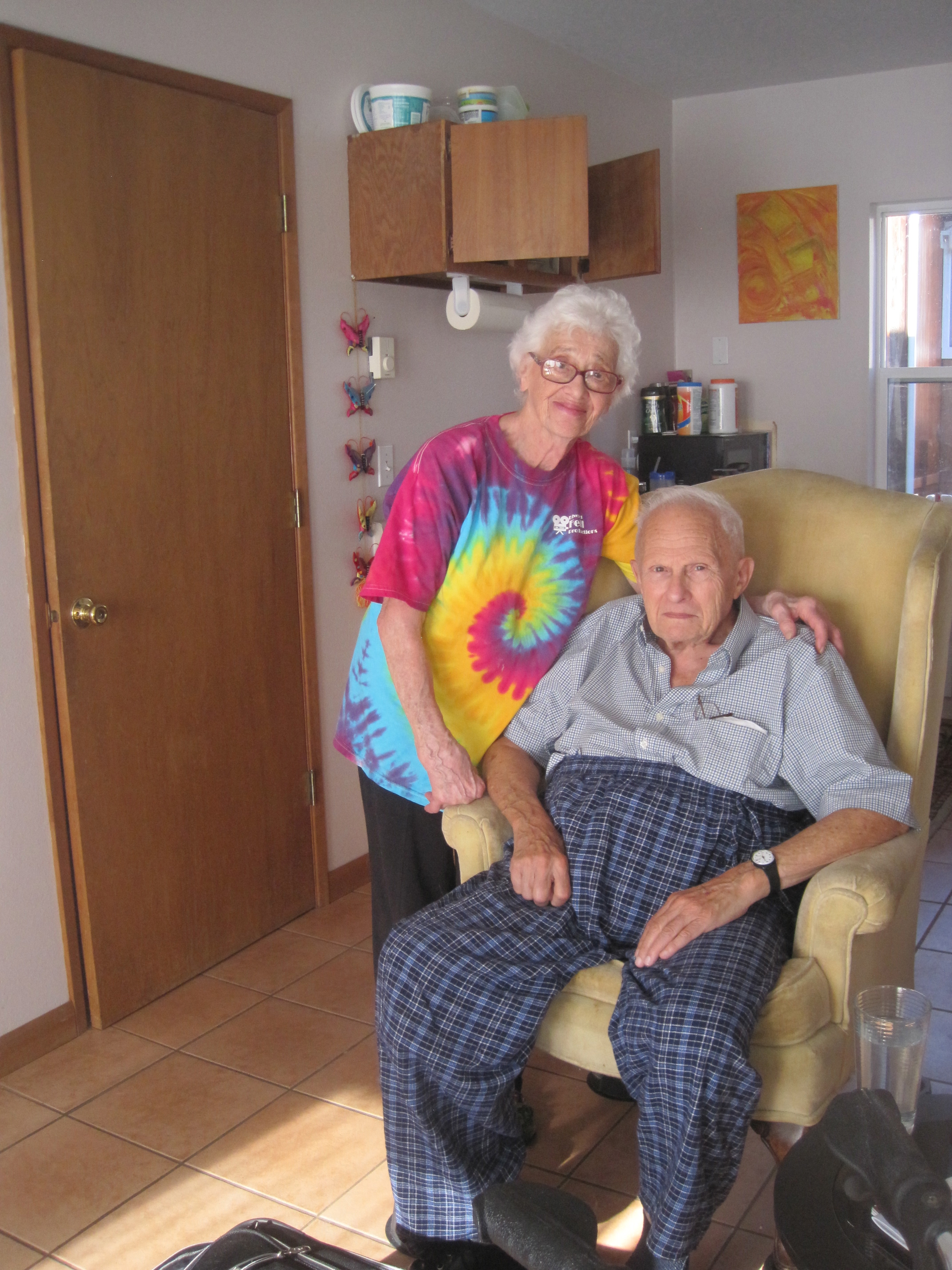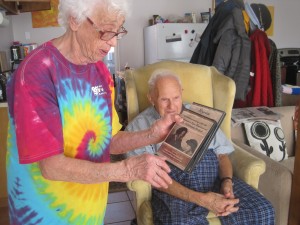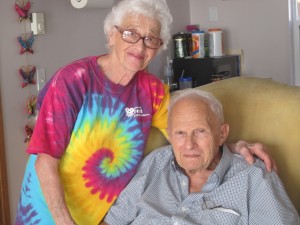There have been a few people that I have interviewed over the years, mostly musicians, who have made huge contributions to their fields. Naomi Feil is one of those influential people. She has devoted her entire career to the advancement of care for our aging populations. I had never heard of Validation Training until my editor at Boomer and Senior News gave me her contact information and asked me to interview her. Turns out, she had lived and worked for decades in Ohio and recently moved just outside of Eugene to be near her one of her sons and his family. They had just moved here about a month before I got to meet her and her husband.
Now, I see on Facebook that there is a video circulating of Naomi holding the tear-streaked face of a black woman while the two of them sing a gospel song together. The “meme” that accompanies this video talks about how a Jewish woman sang a spiritual with an old black woman and how that display of affection shows that religious divides can be overcome. I certainly think this is a positive thing and if it helps relationships improve, I’m all for it.
Naomi showed me this video clip and discussed it at length with me. She never approached this woman as if she was a Jewish woman helping to overcome religious barriers, and I doubt it even occurred to her that this woman was black and from a totally different culture. This woman had been non-verbal for years, and Naomi met with her, knew that in her culture spiritual songs were of great importance, and took a chance that she would relate to the spiritual song “Jesus Loves Me.” She does. The woman cries, and sings along. It’s very touching, especially knowing the background from Naomi, that no one had been able to reach this woman’s soul for so long. Naomi was very proud of that, but also sad, that she is only one person and that there are so many other people like this woman who desperately need someone to reach out to them. After learning about Validation Training and how Naomi came to develop it, I have the utmost respect for her and for this technique.
Boomer and Senior News used this article on the cover of their January 2015 issue, and used a couple of my photos. I couldn’t be more proud or pleased.

Naomi, 81, and Ed Feil, 90, in their new home outside of Eugene. When this photo was taken, Ed had recently had surgery and was recuperating.
Listening with Empathy
Eugene resident Naomi Feil developed Validation Training and widespread changes in the treatment of the elderly.
By Vanessa Salvia
Naomi Feil is well-known the world over for her work with older people with cognitive impairment or dementia. She is the developer of a technique called Validation Training, which is a method of communication with very old people who are also very disoriented from dementia and related illnesses. She was born in 1932, in Munich, Germany, and her development of Validation Training decades ago helped to usher in widespread changes in the therapies that are offered to the very old, very disoriented part of our population.
Feil lives in a farmhouse next door to her son, Ed, and his family. A sign on the front door says ‘Act Old Later.’ She greets me wearing a yellow, fuschia and green tie-dye t-shirt, and it’s clear that Naomi Feil is not a typical 81-year-old. Her husband, also Ed, who is 90 now, recently had surgery and has a mild form of dementia. A sign on the door to the back patio says, ‘Ed! You are living in Eugene, Oregon,’ an important reminder since the Feils recently moved from their home in Cleveland, Ohio, to be near their son.
Feil is a slim, energetic woman with short, snow-white hair who has dedicated her life to helping the aged. Her parents were social workers and psychologists who worked with aging populations. Feil and her family left Germany when she was 4, and she grew up at the Montefiore Home for the Aged in Cleveland, where her father was the administrator and her mother was head of the social services department.
“My undergraduate work was in psychology and my graduate was in group work,” Feil says. After graduating in 1963 she returned to Montefiore and began working with the same people she had grown up with. Back then, there was no understanding of Alzheimer’s disease and how it changes the brain. “They were called ‘senile’ and ‘demented,’ says Feil. “They were given shock treatments.”
Her parents had introduced groundbreaking changes in the way these patients were cared for. Feil’s mother developed the first special services programs for the people at the home. Her father realized the people who were disoriented did not get along with the oriented people. “He made a special wing with more nurses and nursing aids and more stimulation,” she says. “He found out that when people had more stimulation they did better. The psychologists at that time said they shouldn’t have stimulation, that they should just sit because they didn’t want them getting worked up.”
Feil’s father left Montefiore in 1968, and Feil then had to follow the psychology of the time, which was to use ‘reality orientation.’ This meant that if someone spoke about someone from their past, such as their deceased parents or their children, the caregiver should remind them that they are in a home for old people, that their parents are dead and their children aren’t there. “I knew reality orientation was wrong,” says Feil, “but the head nurse made us do it and I had to do what she said. I knew it was not helpful, because I had worked too long with the people and I knew them really well.”
Montefiore invited a filmmaker named Edward Feil to film Naomi working with a small group of very disoriented people. “They asked me to work with him on the script,” she says. Naomi and Ed later married and made several other films together. “I asked Ed to film when I was doing exactly what the head nurse told me to do,” says Naomi.
In that video, Naomi quickly loses control of her group. The women become angry, confused and agitated. One woman, Mrs. Kessler, repeatedly tries to get up and leave the group. Mrs. Ward repeatedly says she needs to talk to her parents. Every time, Naomi responds by reminding them that they are in a home for the aged and what a nice sunny day it is. Mrs. Ward then angrily snaps back, ‘They were my parents. You ought to be shot and hung on the next lamppost.’ “I found out later that Mrs. Ward’s parents had died and she wasn’t there and she felt guilty,” says Feil. “She was seeing her parents in her mind’s eye and she needed to talk to them.”
That video was shown to the staff at Montefiore, and the head nurse responded even more aggressively. “She took Mrs. Kessler and put her in a geri-chair so she couldn’t move, and Mrs. Kessler had to move, so I quit. I couldn’t work there anymore.” Geri-chairs are chairs on wheels that keep the patients fastened in with safety belts. They are designed to make it difficult for the patient to lift their upper body.
At that time, Feil was well on her way to developing Validation Training and began offering workshops all over the country as word of mouth and the films that she and Edward made slowly helped to spread awareness of her new techniques.
Other techniques used today, such as redirection or diversion, use a technique that is sometimes called “the therapeutic lie.” For instance, if someone says, ‘I need to see my mother,’ the caregiver will say, ‘Your mother will come after we take a walk.’ “That’s not helpful,” says Feil. “There’s a reason people want to see their mother and they need to get it out. Some people are afraid to be alone. Some people have unresolved issues with themselves, their parents, or with things that happened to them when they were younger.”
Acknowledgement of deeply felt needs and long-held beliefs is at the core of Validation Training. “I found out that feelings that are kept inside for a long time grow. They don’t go away, they’re submerged and when people get older and they have damage to their brain these feelings come out,” says Feil. “They can’t control them. They’ve been pushed down for so long and if you don’t listen to them, if you redirect them like I did in that film, it shuts them up but the stuff gets submerged further. But if you listen to them and pick up on those feelings, it helps it come out.”
Feil tells of a woman who repeatedly mentioned seeing a man under her bed. Instead of telling her to ignore the man and pretend he’s not there, Feil walked her through her feelings by asking what he looked like and what he was doing. Feil discovered that this woman had been raped, and when she told her mother about it her mother slapped her. “So the woman had to swallow her fear and her anger and her pain,” says Feil. “She kept it inside. You have to listen with empathy. If you don’t, this doesn’t work. You really have to believe that the person sees their children or that something awful happened. The secret to Validation is really empathy.”
Validation Training is designed for people who work in care facilities or nursing homes, although there is a book by Vicki De Klerk-Rubin called Validation Techniques for Dementia Care that is written to help the person taking care of a loved one at home. The author is Ed and Naomi’s daughter who lives in Holland, where she is the European Manager of the Validation Training Institute.
“The adult child learns a lot about themselves by taking care of their parents,” says Feil. “If the dad says, ‘You stole my car keys,’ they are really saying, ‘you took my independence, you took my manhood, you took my potency.”
The caregiver has to acknowledge their own emotions, and understand that what manifests in their relationship as caregiver is often rooted in what happened in their parent’s relationship with their own parents. “If you are feeding and cleaning your mother, you become her mother,” explains Feil. “People use people from present time as symbols from their past. A lot of people who have never accepted aging will accuse other people of stealing their underwear or their jewelry. They’re losing their youth so that becomes a symbol. It’s not at all conscious. We teach the caregivers not to take this personally.”
It takes about a year to learn enough to be a Validation Practitioner. Novices attend a training session, then return to the facility they work for and introduce and document what they learned. They take a training on another topic, and do the same thing. Each level of training is passed through a written test and a demonstration to an instructor, either in-person or through a video.
The next level is Validation Group Practitioner, in which the person starts a group and demonstrates success. People who train further can become Validation teachers, meaning they are authorized to teach Validation at an authorized center. Level four is Validation Master, which allows the person to train and support teachers and contribute to Validation educational curricula.
Naomi Feil continues to travel to Europe three times yearly and to Japan for two weeks each year to lead Validation Training seminars and workshops. Feil maintains this active travel schedule, though she admits she walks more slowly than she used to and asks for a wheelchair when she is in larger airports.
Her methods have been widely accepted across Europe, including in Austria. That tiny country has three Authorized Validation Organizations, whereas there are three AVOs in the entire United States. Part of the reason that Validation is less widespread in the U.S. is that people who attended Feil’s seminars in the 1970s developed their own similar techniques and put their own name on them. “They got some things right,” Feil says, though they misunderstood or ignored other important things.
Ed Feil’s films on gerontology and rehabilitation have been shown internationally and have won numerous awards. Naomi Feil’s books have been translated into French, Dutch, German, Italian, Finnish, Danish, Swedish, Spanish and Japanese.
For more information on Validation Training
(216) 921-6606
www.vfvalidation.org
To get the Validation News newsletter via email
Send a message to: join@vfvalidation.org
For more information on Edward Feil’s films
Edward Feil Productions, LLC
PO Box 2243
Jasper, OR 97438
www.edwardfeilproductions.com

Naomi and Ed Feil in their new home outside of Eugene. Ed is holding one of his paintings, which are hung throughout their home.

Naomi Feil holds some of the DVDs that her husband, Ed, filmed throughout his career. He made several award-winning films on gerontology and rehabilitation issues. They met when Ed was invited to the nursing home where Naomi worked to film her working with elderly residents.


[…] the video, Naomi Feil, a Jewish woman, makes a connection with a woman who suffers from Alzheimer’s by singing […]